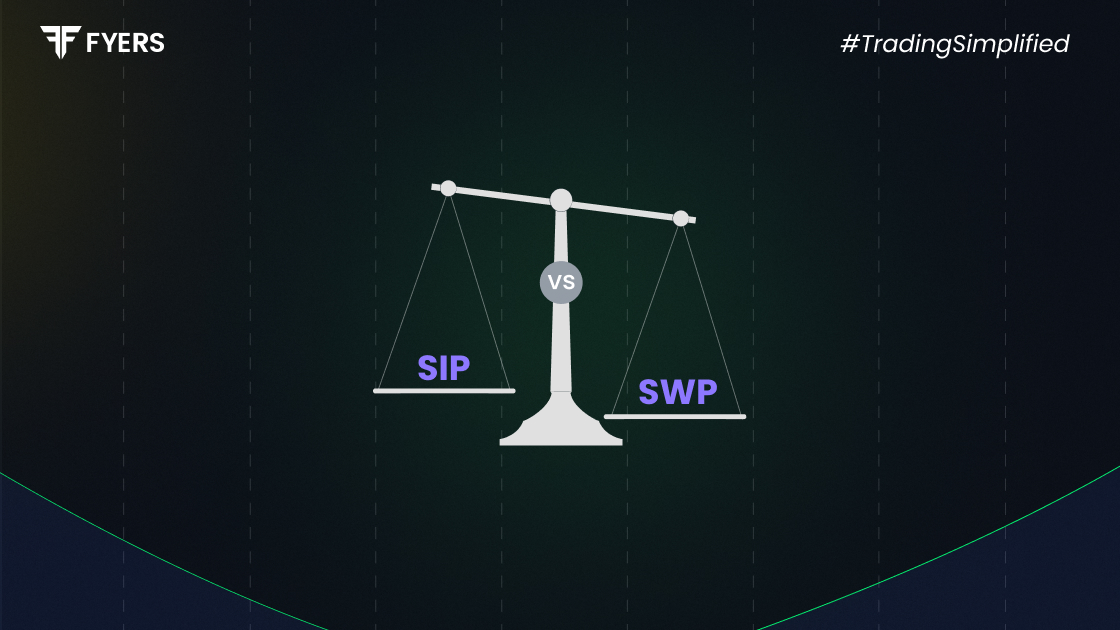

 26 Mar, 2025
26 Mar, 2025
 4 mins read
4 mins read

Choosing the right investment approach matters for your financial success. Whether you want to grow wealth or create income, two popular options exist in mutual funds. These are SIP (Systematic Investment Plan) and SWP (Systematic Withdrawal Plan). Each serves a different purpose. In this article, we will understand what is SIP and SWP, the difference between SWP vs SIP, and a guide to choose which is a better option.
A SIP lets you invest in mutual funds in small amounts over time. Instead of putting in a large sum at once, you contribute fixed amounts daily, weekly, monthly, or quarterly.
Rupee Cost Averaging: When markets fall, your fixed amount buys more units. When markets rise, you buy fewer units. Market volatility effects are minimised through this approach.
Power of Compounding: Your money grows on itself over time. Beginning your investment journey sooner allows for greater potential for wealth accumulation.
Flexibility: You can begin with as little as ₹500 per month. This makes it perfect if you're just starting to invest.
Goal-Oriented: SIPs work well for long-term goals. These might include retirement, your child's education, or buying a home.
A SWP helps you take out money from your mutual fund investments regularly. You can withdraw a fixed sum at set intervals from your mutual fund investments.
Steady Income: You receive a predictable amount on schedule. This helps you plan your expenses better.
Principal Preservation: While you withdraw some money, the rest stays invested. This gives it a chance to continue growing.
Flexibility: You decide how often you would like to receive money.
|
Aspect |
SIP (Systematic Investment Plan) |
SWP (Systematic Withdrawal Plan) |
|---|---|---|
|
Purpose |
Helps you build wealth over time by investing regularly. Creates a disciplined approach to saving and investing. |
Provides regular income from your existing investments. Turns your accumulated wealth into a steady cash flow. |
|
Phase |
Used during the wealth accumulation phase of life. You're still earning and building your financial foundation. |
Used during the wealth distribution phase. You're ready to use the wealth you've built for your needs. |
|
Cash Flow |
Money flows from your bank account into your investments. Your investment corpus grows with each contribution. |
Money flows from your investments back to your bank account. Your investment corpus gradually reduces as you withdraw. |
|
Frequency |
Offers flexible intervals - daily, weekly, monthly, or quarterly. You can choose based on when you receive your income. |
Typically set up as monthly, quarterly, or annual withdrawals to match your expense needs. |
|
Ideal For |
Younger investors, working professionals, and anyone with regular income looking to build wealth for future goals. |
Retirees, individuals needing passive income, or those funding specific recurring expenses like education fees. |
|
Tax Implications |
No immediate tax impact at the time of investment. Tax is applied only when you redeem units, based on the holding period. |
Each withdrawal may trigger capital gains tax. The tax amount depends on the gain portion of your withdrawal amount. |
|
Investment Horizon |
Works best over long periods (5+ years) to benefit from compounding and market cycles. Short-term SIPs lose many advantages. |
Can be set up for both short-term needs (1-3 years) or longer periods like throughout retirement (10-20+ years). |
|
Risk Management |
Reduces investment risk through rupee cost averaging. Market volatility becomes your ally as you buy more units when prices fall. |
Faces the risk of corpus depletion if withdrawal rates exceed growth rates. Market downturns during withdrawal phase can accelerate depletion. |
|
Market Impact |
Benefits from market volatility and downturns. Lower prices mean more units purchased, improving long-term returns. |
Works best in stable or rising markets. Market crashes can force selling units at lower prices, hurting your corpus. |
|
Financial Stage |
Aligns with your earning years when you have surplus income to save regularly after meeting expenses. |
Matches retirement or periods when you need your investments to support your lifestyle expenses. |
SIP is ideal during wealth creation phases (20s-40s) when you have regular income. Its power comes from consistency and time in the market, allowing even modest regular investments to grow substantially over the years.
SWP becomes preferable when you need your investments to support your lifestyle, typically during retirement or when requiring additional income. It creates a personal "salary" from your investments while allowing the remaining portfolio to continue growing.
Both SIP and SWP serve as valuable tools for different financial needs. When you want to grow wealth, SIP offers a better path. When you need a steady income from your investments, SWP becomes your ally. The choice between SIP and SWP comes down to your current situation and goals.
SIP is for putting money in. You invest small amounts regularly to grow your wealth. SWP is for taking money out. You withdraw small amounts regularly to get income from your investments.
Yes, simultaneous utilisation of both options is possible. You can put money into some investments with SIP. You can take money out from other investments with SWP. This lets you build wealth while also getting regular income.
Calculate your Net P&L after deducting all the charges like Tax, Brokerage, etc.
Find your required margin.
Calculate the average price you paid for a stock and determine your total cost.
Estimate your investment growth. Calculate potential returns on one-time investments.
Forecast your investment returns. Understand potential growth with regular contributions.